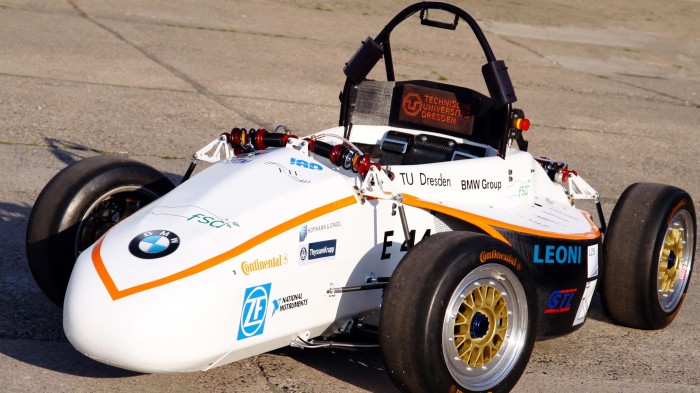Areus

Key Facts
| Weight: | 336 kg |
| Engine Power: | 2 x 30 kW |
| Voltage: | 435 V |
| Acceleration (0-100 km/h): | 4.2 sec |
| Maximum Velocity: | 120 km/h |
Chassis
The chassis of the vehicle consists of a carbon fibre composite monocoque, which was put together from two half pieces. Behind the driver it accommodates the drive motors, batteries and inverter. First, the monocoque was produced with a VARI (Vacuum Assisted Resin Injection) process. The resin hardener mixture is introduced under vacuum. The frames and side impact protection are directly incorporated into the monocoque structure.
The side pods are also constructed from CFRP, as a self-supporting structure. They reduce the air resistance and protect components of the cooling and control electronics from climatic hazards.
Suspension
The chassis suspension was specially designed for the requirements of an electric vehicle. During the construction phase, the kinematic properties of the vehicle were analysed though a multiple-body simulation (ADAMS) and tyre data.
For the weight reduction, the wishbones are made from carbon fibre tubes with aluminium inserts. The uprights must withstand high and heterodyne forces during driving. Through iterative FEM calculations we could find the optimal geometry for the new uprights. In comparison with last season we could obtain higher performance while reducing weight by 20%.
Electric Propulsion System
Areus is powered at the rear wheels by two water cooled brushless synchronous motors with a power of 30kW at maximum torque of 80Nm. Through high efficiency they provide a lower moment of inertia. Both motors are fixed to a mount that sits on the back plate. They reinforce the monocoque against shear forces, take the chain drive, and make quick and easy motor removal possible.
Due to a doubled chain drive, both motors are individually controllable. They may be driven differently by Areus according to sensor data. This regulated drive distribution makes higher cornering speeds and better acceleration possible. For the cheapest possible strength to weight ratio, the chain rings and back plate were topology optimised.
Battery and Energy supply
In order to provide the motors with electricity, the vehicle includes two inverters. They transform the DC current from the accumulators into AC current and regulate electricity flow to the motors. The electrical energy is applied by a self-developed high voltage accumulator, which consists of two rows of series connected batteries. The container is made from CFRP, with additives to minimise fire risk. Through this solutions the accumulators can be removed and inserted in a maintenance friendly fashion. In the housing 924 LiFePo4 cells are integrated. A TU Dresden developed battery management system looks after the cells and protects from critical situations.
Electics
The electronics of the car have become more complex and powerful in the wake of the new drive concept. Signals are processed on a central on board computer via a range of sensors. For example, the rotational speeds of the four wheels are detected, the front and rear brake pressures measured and the longitudinal acceleration and yaw rate for all three spatial axes read out via a 6-axis sensor module. The pedal angle is read by a four-fold redundant measurement, as the electric motor lacks mechanical feedback. All sensor data can be read wirelessly by a PC or laptop. This allows us to diagnose and solve problems quickly. The Traction System Active Light (TSAL) and TUD design brake light are manufactured by Elbflorace with LEDs.
